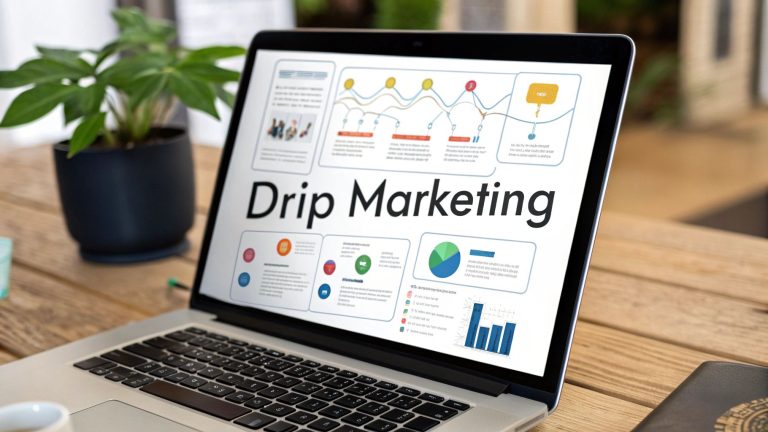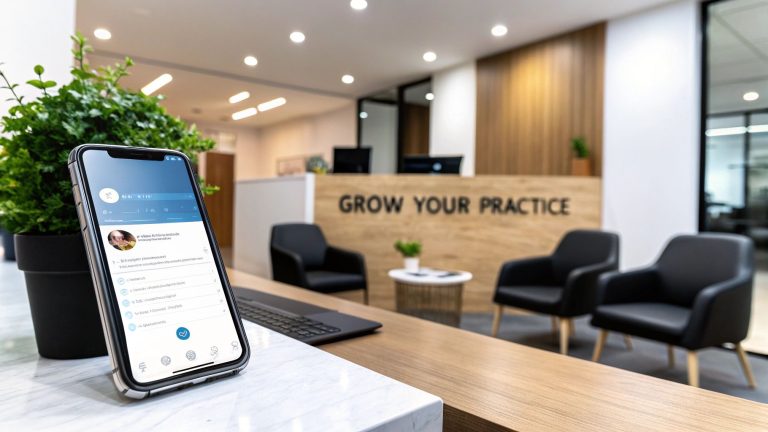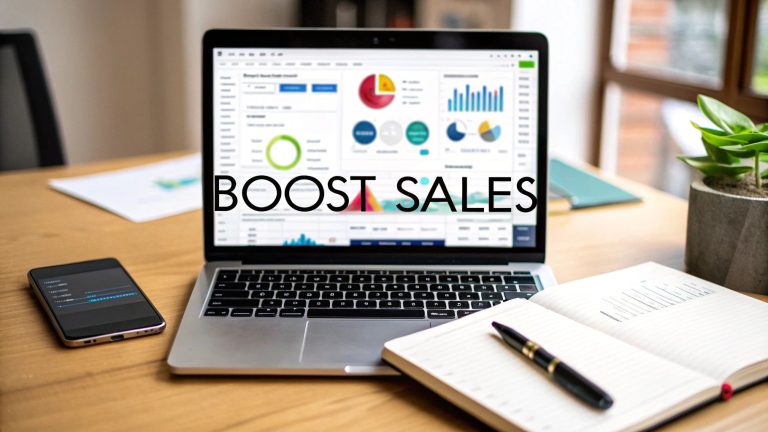Automated Lead Nurturing: Your Complete Success Blueprint
Why Automated Lead Nurturing Changes Everything
Think of automated lead nurturing as your tireless digital assistant, always ready with the perfect message at the right moment. While your competitors chase leads manually, you're building a system that works around the clock, turning curious browsers into loyal customers. Imagine a SaaS startup struggling with a 2% conversion rate. With smart automated lead nurturing, they boosted it to 18% – almost overnight. That's the power of working smarter, not harder.
This isn't about spamming generic emails and hoping for the best. The old "spray and pray" method is not only ineffective, it hurts your brand. People want personalized experiences, and generic blasts say "I don't care about you." Automated lead nurturing lets you deliver the right message to the right person at the right time, building real connections at scale.
Why the Human Touch Still Matters
Now, you might be wondering: "Doesn't automation make things feel robotic?" Not at all. It's actually the opposite. By automating repetitive tasks, you free up your team to focus on what humans do best: building relationships. Think of it this way: automation handles the logistics, while your team adds the personal touch. It's not about replacing human connection; it's about enhancing it with intelligent, consistent messaging.
For example, let's say a prospect downloads a guide from your website. Your automated system instantly sends a thank you email with helpful next steps, like an invitation to a webinar. If they attend, the system triggers a follow-up from a sales rep offering a personalized consultation. This blends automation with human interaction for a seamless, high-touch experience.
The Power of Personalized Engagement
Automated lead nurturing allows you to segment your audience based on their behavior, interests, and demographics. You can tailor your messages to each individual, addressing their specific needs. Instead of generic product pitches, you provide valuable information that helps them solve their problems. This builds trust and positions your brand as a helpful resource, not just another sales pitch.
Plus, automated lead nurturing has a proven track record of increasing qualified leads. Companies using these systems have seen a 451% increase in qualified leads. Discover more insights on lead nurturing here. This shows the impact of targeted, personalized engagement.
Building a Sustainable Growth Engine
Ultimately, automated lead nurturing isn't just a tactic; it's a new way of approaching marketing and sales. It's about building a sustainable growth engine. By automating the tedious work, you empower your team to focus on strategy, creativity, and building strong relationships. This is how you outpace the competition and build a brand that truly connects with your audience.
Understanding How Your Prospects Really Think and Buy

Many marketers build lead nurturing sequences imagining how they would buy something. They plan emails on a set schedule, regardless of whether a prospect is actually interested. But this misses something big: what's happening inside the prospect's head. They have their own private doubts, questions, and late-night worries you don't see.
The Emotional Rollercoaster of Buying
The buyer's journey isn't a straight line. Think of it more like a rollercoaster of emotions. Prospects go from curiosity and excitement to skepticism and maybe even a little fear. Effective automated lead nurturing recognizes these emotional ups and downs. Instead of focusing on sending emails every few days, successful companies connect their messages to these specific feelings.
For example, someone who just downloaded a whitepaper is probably feeling positive and wants to learn more. That's the perfect moment to offer them additional resources that build on their interest. But what about someone who keeps checking your pricing page but hasn't reached out? They might be hesitant about the cost. A different kind of message—one that addresses their concerns or offers a payment plan—would work better.
Trust Micro-Moments: The Building Blocks of Confidence
Think about little interactions you have with a brand. A helpful support agent. A clear and easy-to-use website. A personalized email that actually gets you. These are trust micro-moments. Each one, no matter how small, either builds confidence or creates doubt. Automated lead nurturing lets you create these micro-moments on purpose.
Also, think about getting ahead of objections. By addressing potential concerns before they're even voiced, you show empathy and build trust. This makes the whole process feel less like marketing and more like helpful guidance. In fact, lead nurturing emails get 4 to 10 times higher response rates than standard email blasts. Discover more insights on lead nurturing here. That shows the real power of personalized, targeted communication.
Nurturing as a Conversation
The best automated lead nurturing feels like chatting with a trusted advisor. Someone who gets your challenges and offers useful advice. This means ditching generic messages and creating content that connects with each prospect's specific needs and goals. You might be interested in: Check out our guide on CRM and lead generation. This is where automation shines – creating personal experiences at scale. This builds real connections that turn into long-term customers and lasting business growth.
Building Your First Automated Lead Nurturing System That Actually Works
Ready to ditch the guessing games and start turning prospects into customers systematically? Let's build your automated lead nurturing engine, brick by brick, beginning with the crucial (and often overlooked) foundation: lead qualification and behavioral scoring.

This infographic shows the core automated lead nurturing process, from initial capture to targeted follow-up. Notice how it starts with capturing leads, then segments and scores them before any automated emails go out. This highlights a key point: effective nurturing isn’t just about sending emails—it’s about sending the right emails to the right people. Want to learn more about automating the lead generation process itself? Learn more in our article about how to automate lead generation.
From Welcome to Re-Engagement: Crafting Your First Workflow
Think of your automated lead nurturing system like a series of carefully arranged dominoes. The first one topples when a prospect fills out a form, downloads something, or subscribes to your newsletter. This sets off your welcome sequence: a series of emails designed to set expectations, provide value, and understand your new lead's interests.
This isn’t about hitting them with a sales pitch right away. It's about building a relationship. For example, your first email might be a simple thank you with helpful links to relevant blog posts or case studies. The second email could invite them to a webinar or offer a free trial. The third might segment them based on their response, tailoring future messages to their specific needs.
What about those prospects who go quiet? A re-engagement campaign is your answer. This workflow kicks in after a period of inactivity, rekindling interest with valuable content or special offers. It’s a gentle reminder of the value you offer.
Trigger-Based Messaging: Responding to Real Actions
Truly effective automated lead nurturing is built on trigger-based messaging. This means your system reacts to what people do, not just arbitrary timelines. For example, if a prospect checks out your pricing page several times, it could trigger an email addressing cost concerns or offering a consultation. Downloading a particular ebook could trigger a workflow focused on that specific topic.
This is where behavioral scoring shines. By assigning points to various actions, you pinpoint highly engaged leads and fine-tune your messaging. A prospect who downloads multiple resources, attends a webinar, and visits your pricing page is clearly more interested than someone who just signed up for your newsletter. Your system should recognize this and adjust its communication accordingly.
Mapping Content to Buyer Personas: The Relevance Factor
Successful nurturing relies on relevant content delivered at the right time. This means matching your content to different buyer personas and stages of their decision-making process. A small business owner has different needs and challenges than a corporate executive. Your system should recognize these differences and provide personalized content that resonates.
Content also needs to match where the prospect is in their buying journey. Early on, educational content is king. As they get closer to a purchase, case studies, testimonials, and product comparisons become more relevant. Effective automated lead nurturing systems understand this progression and deliver the right content at each stage.
Balancing Automation with the Human Touch
Automation does the heavy lifting, but never forget the importance of the human touch. Think of your system as a helpful assistant, freeing up your team to focus on building genuine relationships. A well-timed phone call or personalized email from a sales rep can make a huge difference, especially for highly engaged leads. The key is finding the right balance between automation and strategic human interaction. This blended approach ensures every interaction feels personalized and valuable, maximizing your chances of converting prospects into loyal customers.
Let's look at some real-world examples of successful automated lead nurturing workflows:
The following table showcases different approaches tailored to various business types. Pay attention to how the sequence length, trigger points, and conversion rates vary based on industry and target audience.
Proven Automated Lead Nurturing Workflows By Business Type
| Business Type | Primary Workflow | Email Sequence Length | Key Trigger Points | Average Conversion Rate |
|---|---|---|---|---|
| E-commerce | Abandoned Cart | 3-4 emails | Adding item to cart, initiating checkout, browsing related products | 2-5% |
| SaaS | Free Trial | 7-10 emails | Sign-up, feature usage, nearing trial end | 10-20% |
| Real Estate | Property Updates | Ongoing | New listings, price changes, open house reminders | Varies widely |
| Consulting | Lead Magnet Download | 5-7 emails | Downloading resource, visiting specific pages, engaging with content | 5-10% |
As you can see, there's no one-size-fits-all solution. The most effective workflow will depend on your specific business, target audience, and goals. By carefully considering these factors and implementing the strategies we've discussed, you can create an automated lead nurturing system that truly delivers results.
Choosing Tools That Grow With Your Ambitions
The marketing automation landscape offers a lot of choices. How do you pick the right tools without breaking the bank or your team’s spirit? Let’s skip the marketing jargon and focus on building a nurturing tech stack that actually fits your business, not just a laundry list of features.

This screenshot shows HubSpot's marketing automation software, with features like lead capture, email marketing, and analytics. The visual workflow management in HubSpot's interface makes it easy to use, especially for businesses new to automation. This reflects a broader shift towards user-friendly design and integrated features in marketing automation platforms, simplifying complex workflows.
Evaluating Tools Based on Your Workflow
Think of your automated lead nurturing like a well-oiled machine. Each tool is a part, and they all need to work together smoothly. Resist the temptation of long feature lists. Focus on the tools you need to reach your specific nurturing goals. A simple email marketing platform with basic automation might be enough for a small business just starting out. As your business expands, you might need a more powerful system integrated with your CRM and advanced analytics.
For example, imagine a growing e-commerce business focused on recovering abandoned carts and sending targeted product recommendations. A platform with strong e-commerce integrations and robust segmentation capabilities would be ideal. On the other hand, a large B2B company with complex sales cycles might require a more sophisticated system for lead scoring, multi-channel nurturing, and sales automation.
Hidden Costs and Unexpected Benefits
Chatting with businesses that have already switched platforms can offer invaluable real-world insights. What challenges did they face? What unexpected advantages did they find? Sometimes, the cheapest option becomes the most costly due to hidden factors like implementation time, training, or limited scalability.
Investing in a more robust platform upfront can save you time and money in the long run. It can provide more flexibility, deeper integration with other tools, and more sophisticated automation capabilities.
Integrating Your Tech Stack for Seamless Experiences
Successful companies create automated lead nurturing systems that feel natural to potential customers while providing valuable data to the marketing team. This involves integrating your CRM, email marketing platform, and analytics tools. Picture this: a prospect downloads a lead magnet from your website. The information automatically goes into your CRM, starting a personalized welcome email series. Their engagement with these emails is tracked and analyzed, giving you information to improve future nurturing efforts. This connected approach creates a better experience for the prospect and gives your marketing team valuable data.
Real-World Scenarios and Practical Considerations
Let’s look at a real example. A software company was struggling with low trial conversion rates. They introduced an automated lead nurturing system that sent personalized emails based on how users interacted with the trial. If a user explored a certain feature, they received a helpful tutorial. If they seemed less engaged, they got a targeted re-engagement email. This personalized approach greatly improved their conversion rates.
Implementing automated lead nurturing isn’t just about the tech; it’s about the strategy, the team, and the process. Think about realistic implementation timelines, training needs, and the potential cost of mistakes. Getting it right from the start avoids future problems and sets you up for lasting success.
Before diving into specific platforms, take a look at this comparison table built from real user feedback. It helps cut through the marketing hype and provides a more grounded perspective on what to expect.
Automated Lead Nurturing Platform Reality Check: Honest comparison of popular platforms showing actual costs, implementation effort, and best-fit scenarios based on real user experiences
| Platform | Best Suited For | Standout Features | Real Starting Cost | Setup Complexity | Growth Flexibility |
|---|---|---|---|---|---|
| HubSpot | Small to medium businesses, marketing-focused teams | Ease of use, all-in-one platform, strong educational resources | $450/month | Easy to Moderate | High |
| Marketo | Enterprise businesses, complex sales cycles | Advanced automation, robust analytics, extensive integrations | $899/month | Moderate to Complex | High |
| Pardot | B2B businesses using Salesforce, sales and marketing alignment | Tight Salesforce integration, lead scoring, email marketing | $1250/month | Moderate to Complex | High |
| Mailchimp | Small businesses, basic email automation | User-friendly interface, affordable pricing, simple automation | $9.99/month | Easy | Moderate |
| ActiveCampaign | Growing businesses, advanced automation needs | Powerful automation workflows, CRM features, affordable pricing | $29/month | Easy to Moderate | High |
Key takeaways from the table: while HubSpot and Mailchimp excel in ease of use, Marketo and Pardot offer more sophisticated features for larger enterprises. ActiveCampaign stands out for providing a good balance between advanced automation and affordable pricing. Your ideal choice depends on your specific needs and budget.
Advanced Strategies That Separate Market Leaders From Followers
You've got the basics of automated lead nurturing down, so let's explore the tactics that truly elevate top performers. Think about it: a prospect checks your pricing page several times but never buys. What's going on?
This is where behavioral trigger sequences shine. These sequences pick up on subtle cues that many marketers miss. For example, that repeat pricing page visitor might get an email addressing cost concerns or offering a one-on-one chat.
Progressive Profiling: Building Complete Customer Pictures
Imagine creating detailed customer profiles without long surveys or pushy data collection. That's the power of progressive profiling. It gathers information bit by bit, asking a few key questions at each touchpoint.
This respects privacy and avoids overwhelming prospects, all while enriching your customer data. It builds a deeper understanding of each person's unique needs and preferences.
Multi-Channel Mastery: Reaching Prospects Where They Are
Top companies don't rely solely on email. They know prospects interact across various channels. Multi-channel nurturing uses email, social media, retargeting ads, and even direct mail for a more impactful reach.
Think of it this way: a prospect gets a personalized email, sees a related social media ad, and then finds a targeted offer when they revisit your website. This unified approach creates a much stronger, more memorable impression.
Advanced Personalization: Making Every Interaction Count
Generic messages just don't work anymore. Prospects expect personalized experiences. Dynamic content and AI-driven recommendations tailor every interaction to individual behaviors and preferences. This could mean suggesting products based on past purchases or customizing email content based on website activity.
Companies that excel at lead nurturing generate 50% more sales-ready leads at a 33% lower cost per lead. And here's another compelling statistic: roughly 63% of leads who aren't initially ready to buy can eventually convert with the right nurturing strategy. Discover more insights here.
Negative Nurturing: The Art of Graceful Disengagement
Not every prospect is a perfect match. Negative nurturing is the art of gently disengaging while maintaining a positive brand image. This could involve unsubscribing them from certain email lists, providing alternative resources, or pointing them towards solutions that better suit their needs.
Done correctly, negative nurturing can even turn unsuitable prospects into valuable referrals. You might be interested in: Read also: Marketing process optimization.
By using these advanced strategies, you can transform automated lead nurturing from a basic system into a powerful growth engine. It's not just about boosting conversions; it's about building real relationships and positioning your brand as a trusted resource.
Measuring What Actually Matters For Real Business Growth
Stop obsessing over vanity metrics like open rates. They might give you a tiny peek into engagement, but they don't reveal the full picture. To really grasp the impact of your automated lead nurturing, you need to dig deeper – focus on metrics that have a direct link to business growth. This means tracking lead velocity, revenue attribution, and the long-term effects on customer lifetime value.

This screenshot shows a Google Analytics dashboard, giving you a visual overview of important website metrics. See how it goes beyond simple open rates to provide insights into where your traffic is coming from, how users behave on your site, and whether you're meeting your conversion goals? These deeper insights are vital for understanding the complete impact of your automated lead nurturing work.
Analyzing data within platforms like Google Analytics reveals the real story behind your nurturing. Knowing emails are opened isn't enough; you need to know if those opens turn into meaningful actions further down the line. This means tracking conversions, spotting any roadblocks, and ultimately, figuring out your return on investment.
Beyond Open Rates: Metrics That Predict Success
Lead velocity measures how quickly leads move through your sales pipeline. Higher velocity suggests your nurturing is effectively pushing leads towards conversion. Think of it like a river: the faster the current, the quicker it reaches the ocean (your sales goal!).
Revenue attribution connects specific nurturing campaigns to actual sales. This helps you pinpoint which sequences are bringing in the most money and prove the ROI of what you're doing. By accurately attributing revenue, you can show stakeholders the real value of automated lead nurturing.
Finally, customer lifetime value (CLTV) captures the long-term effect of your nurturing. Effective nurturing not only turns leads into customers, but also builds loyalty, encouraging repeat purchases and higher CLTV. Picture a well-cared-for garden – with consistent nurturing, it yields a great harvest season after season.
Setting Up Tracking for Clear ROI
Accurate tracking is the foundation of smart, data-driven choices. This means integrating your marketing automation platform with your CRM and analytics tools. When these systems work together, you get a complete picture of the customer journey. It's like a detective piecing together clues – the more data points you have, the clearer the case becomes.
You should track important actions within your nurturing sequences, such as email clicks, website visits, content downloads, and form submissions. This detailed tracking offers insights into lead engagement and helps identify bottlenecks in your funnels.
Testing and Optimization: The Continuous Improvement Cycle
A/B testing is crucial for refining your nurturing campaigns. Start with easy tests, like comparing different subject lines or calls to action. As you gain experience, experiment with more complex variations, such as testing whole sequence structures or various content offers. It's like a scientist conducting experiments – by methodically testing different things, you discover what works best.
Don't just test once and forget it. Continuous optimization is essential for long-term success. Regularly review your data, find areas to improve, and make changes based on what you learn. This iterative process ensures your automated lead nurturing campaigns remain effective and aligned with your business goals as they change.
Identifying and Fixing Bottlenecks: Smooth Flow for Maximum Conversions
By looking at your tracking data, you can pinpoint where leads are getting stuck in your nurturing funnels. These bottlenecks could be anything from unclear email copy to a confusing call to action on a landing page. It's like a plumber fixing a leak – by finding and fixing the problem, you restore the flow.
Once you've found a bottleneck, try out different solutions. If leads aren't clicking a specific call to action, try rewriting it, moving it, or offering a different incentive. By constantly testing and improving, you ensure a smooth journey through your funnels.
Scaling for Growth: Maintaining Performance Across Segments
As your business grows, you'll want to scale your winning nurturing campaigns across different groups and markets. But, it's vital to maintain performance as you expand. Think of it like a chef replicating a great recipe – while adjusting the portion size, they carefully preserve the balance of ingredients to keep the original taste.
When scaling your campaigns, consider factors like cultural differences, language barriers, and varying customer preferences. Adjust your messaging and content to resonate with each specific audience while staying true to your core brand message. By carefully adapting your approach, you can successfully scale your automated lead nurturing without sacrificing its effectiveness.
Your Implementation Roadmap And Costly Mistakes To Avoid
Ready to transform your marketing with automated lead nurturing? This roadmap, built on real-world experience, guides you through a practical 90-day implementation plan. We'll also explore the timeline for seeing results, sharing insights from marketing leaders who've been down this road before – including the bumps they hit and the clever solutions they found.
Phase 1: Foundational Setup (Days 1-30)
The first 30 days are about laying the groundwork. It's less about launching dazzling campaigns and more about building a strong foundation. Think of it like prepping a garden bed – the healthier the soil, the better everything grows.
-
Define Your Ideal Customer: Who are you trying to connect with? What keeps them up at night? Creating detailed buyer personas makes sure your messages resonate.
-
Data Cleanup: Bad data is like a clogged drain. It hinders your nurturing efforts. This is the time to clean your CRM (Customer Relationship Management), segment your audience, and set clear lead scoring rules.
-
Choose Your Tools: Select the right automation platform for your needs and budget. Consider how it integrates with your existing CRM and marketing software.
-
Initial Workflow Setup: Keep it simple at first. Create a welcome series for new leads and a re-engagement campaign for those who've gone quiet.
Phase 2: Building Momentum (Days 31-60)
With your foundation in place, the next 30 days are about gaining momentum. This is where you start seeing early wins – the kind that energize your team and demonstrate the value of your work.
-
Testing and Refining: Start A/B testing emails, subject lines, and calls to action. What's clicking with your audience?
-
Content Mapping: Align your content with each stage of the buyer's journey. Offer valuable resources that address their specific needs and concerns.
-
Expand Your Workflows: Introduce trigger-based emails for actions like website visits, downloaded content, or event registrations.
-
Early Performance Analysis: Check your metrics. What's working? What's not? Make adjustments based on the data.
Phase 3: Scaling and Optimizing (Days 61-90)
The final 30 days focus on scaling your successes and creating a continuous improvement loop.
-
Multi-Channel Integration: Expand your nurturing beyond email. Include social media, retargeting ads, and even direct mail.
-
Advanced Personalization: Use dynamic content and AI-driven recommendations for truly personalized experiences.
-
Negative Nurturing: Develop a strategy to disengage unqualified leads gracefully while keeping a positive brand image.
-
Long-Term Measurement: Shift your focus from vanity metrics to revenue attribution, lead velocity, and customer lifetime value.
Common Pitfalls (and How to Avoid Them)
Many automation projects stumble, not because of the tech, but because of strategic errors.
-
Over-Automation: Don't automate everything. Maintain some personal touchpoints, especially for high-value leads. Find the right balance between automation and genuine human interaction.
-
Poor Data Hygiene: Bad data in, bad data out. Clean, organized data is crucial for targeted nurturing. Regular data audits and consistent data entry are key.
-
Marketing and Sales Misalignment: Nurturing isn't just marketing's job – it's a shared responsibility. Ensure clear communication and common goals between marketing and sales to avoid friction.
-
Unrealistic Expectations: Automated lead nurturing takes time. Don't expect instant miracles. Focus on building a sustainable system for long-term results.
By following this roadmap and learning from others' experiences, you can implement automated lead nurturing effectively, boosting your marketing results and building stronger customer relationships.
Ready to streamline your Facebook lead capture and kickstart your automated lead nurturing? Check out LeadSavvy Pro and transform how you connect with potential customers.







